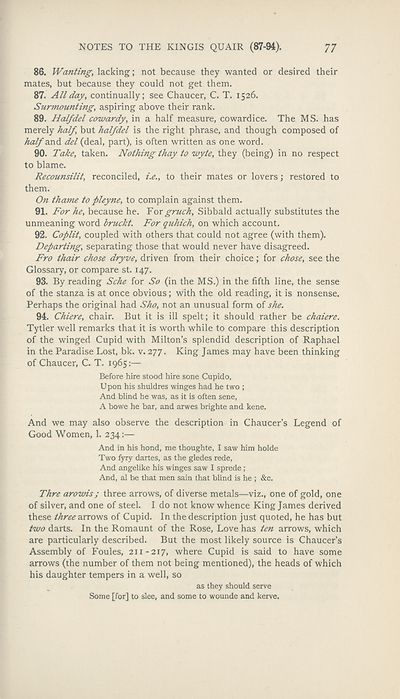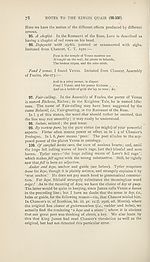Download files
Complete book:
Individual page:
Thumbnail gallery: Grid view | List view

NOTES TO THE KINGIS QUAIR (87-94).
77
86. Wanting, lacking; not because they wanted or desired their
mates, but because they could not get them.
87. All day, continually; see Chaucer, C. T. 1526.
Surmounting, aspiring above their rank.
89. Halfdel cowardy, in a half measure, cowardice. The MS. has
merely half, but halfdel is the right phrase, and though composed of
half and del (deal, part), is often written as one word.
90. Take, taken. Nothing thay to wyte, they (being) in no respect
to blame.
Recounsilit, reconciled, i.e., to their mates or lovers; restored to
them.
On tha7ne to fleyne, to complain against them.
91. For he, because he. Yor gruch, Sibbald actually substitutes the
unmeaning word bruckt. For quhich, on which account.
92. Coplit, coupled with others that could not agree (with them).
Departing, separating those that would never have disagreed.
Fro thair chose dryve, driven from their choice ; for chose, see the
Glossary, or compare st. 147.
93. By reading Sche for So (in the MS.) in the fifth line, the sense
of the stanza is at once obvious; with the old reading, it is nonsense.
Perhaps the original had Sho, not an unusual form of she.
94. Chiere, chair. But it is ill spelt; it should rather be chaiere.
Tytler well remarks that it is worth while to compare this description
of the winged Cupid with Milton’s splendid description of Raphael
in the Paradise Lost, bk. v. 277. King James may have been thinking
of Chaucer, C. T. 1965:—
Before hire stood hire sone Cupido,
Upon his shuldres winges had he two ;
And blind he was, as it is often sene,
A bowe he bar, and arwes brighte and kene.
And we may also observe the description in Chaucer’s Legend of
Good Women, 1. 234:—
And in his hond, me thoughte, I saw him holde
Two fyry dartes, as the gledes rede,
And angelike his winges saw I sprede ;
And, al be that men sain that blind is he ; &c.
Thre arowis; three arrows, of diverse metals—viz., one of gold, one
of silver, and one of steel. I do not know whence King James derived
these three arrows of Cupid. In the description just quoted, he has but
two darts. In the Romaunt of the Rose, Love has ten arrows, which
are particularly described. But the most likely source is Chaucer’s
Assembly of Foules, 211-217, where Cupid is said to have some
arrows (the number of them not being mentioned), the heads of which
his daughter tempers in a well, so
as they should serve
Some [for] to slee, and some to wounde and kerve.
77
86. Wanting, lacking; not because they wanted or desired their
mates, but because they could not get them.
87. All day, continually; see Chaucer, C. T. 1526.
Surmounting, aspiring above their rank.
89. Halfdel cowardy, in a half measure, cowardice. The MS. has
merely half, but halfdel is the right phrase, and though composed of
half and del (deal, part), is often written as one word.
90. Take, taken. Nothing thay to wyte, they (being) in no respect
to blame.
Recounsilit, reconciled, i.e., to their mates or lovers; restored to
them.
On tha7ne to fleyne, to complain against them.
91. For he, because he. Yor gruch, Sibbald actually substitutes the
unmeaning word bruckt. For quhich, on which account.
92. Coplit, coupled with others that could not agree (with them).
Departing, separating those that would never have disagreed.
Fro thair chose dryve, driven from their choice ; for chose, see the
Glossary, or compare st. 147.
93. By reading Sche for So (in the MS.) in the fifth line, the sense
of the stanza is at once obvious; with the old reading, it is nonsense.
Perhaps the original had Sho, not an unusual form of she.
94. Chiere, chair. But it is ill spelt; it should rather be chaiere.
Tytler well remarks that it is worth while to compare this description
of the winged Cupid with Milton’s splendid description of Raphael
in the Paradise Lost, bk. v. 277. King James may have been thinking
of Chaucer, C. T. 1965:—
Before hire stood hire sone Cupido,
Upon his shuldres winges had he two ;
And blind he was, as it is often sene,
A bowe he bar, and arwes brighte and kene.
And we may also observe the description in Chaucer’s Legend of
Good Women, 1. 234:—
And in his hond, me thoughte, I saw him holde
Two fyry dartes, as the gledes rede,
And angelike his winges saw I sprede ;
And, al be that men sain that blind is he ; &c.
Thre arowis; three arrows, of diverse metals—viz., one of gold, one
of silver, and one of steel. I do not know whence King James derived
these three arrows of Cupid. In the description just quoted, he has but
two darts. In the Romaunt of the Rose, Love has ten arrows, which
are particularly described. But the most likely source is Chaucer’s
Assembly of Foules, 211-217, where Cupid is said to have some
arrows (the number of them not being mentioned), the heads of which
his daughter tempers in a well, so
as they should serve
Some [for] to slee, and some to wounde and kerve.
Set display mode to: Large image | Zoom image | Transcription
Images and transcriptions on this page, including medium image downloads, may be used under the Creative Commons Attribution 4.0 International Licence unless otherwise stated. ![]()
| Publications by Scottish clubs > Scottish Text Society publications > Old series > Kingis quair > (137) |
|---|
| Permanent URL | https://digital.nls.uk/106994119 |
|---|
| Description | A collection of over 100 Scottish texts dating from around 1400 to 1700. Most titles are in Scots, and include editions of poetry, drama, and prose by major Scottish writers such as John Barbour, William Dunbar, Gavin Douglas, and George Buchanan. Edited by a key scholarly publisher of Scotland's literary history, and published from the late 19th century onwards by the Scottish Text Society. Available here are STS series 1-3. |
|---|

